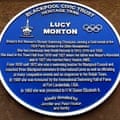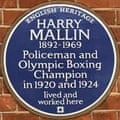July 14, 1924, Paris. Lucy Morton started and sat up on the sidewalk. She was surrounded by piercing shouts. French. The taxi she had been in seconds before was parked in the middle of the road, and another taxi appeared to be parked on the road. As she began to regain consciousness, she concluded that the impact of the crash must have thrown her from the cab and knocked her to the street. She felt blood running down her face and noticed her five teeth lying next to her.
Her teammates on the British Olympic swimming team were pale and sobbing, and as the 200m breaststroke began two days later, she realized her Olympic adventure had taken a turn for the worst.
The 26-year-old from Blackpool left England a potential medalist but certainly not the favorite to win gold. It will be a battle between her compatriot and world record holder Erin Gilbert and America’s favorite Agnes Geraghty.

In 1916 Morton broke the 150 yard backstroke world record and won titles in grueling open water swims on the Thames, Mersey and Morecambe Bay. But with the 1916 Olympics being cancelled, and her events not being included in the 1920 Olympics, it was widely believed that she might have lost her best form.
A year before the Paris Olympics she was working full-time at St Anne’s Post Office and Blackpool Council opened the local bathhouse for her so she could train before and after work.
She performed well enough to join 13 female swimmers on Team GB and fight their way to the final in the open-air Piscine des Tourelles. On the morning of the final, more bad news came to the team. Gilbert fell ill overnight and was unsure if she could swim. In Lucy’s words, the local doctor “cleaned her mouth out” the previous afternoon and gave her some painkillers, which seemed to have helped. Everything was going wrong, but she felt fine and strangely calm.
Years later, during a school talk, she was persuaded to tell the story of the race. “I decided that if I could keep up with Erin, I should be in second place, so off we went,” she said. “I lost Erin on the second turn, but I felt like I had her to thank for the first length because she seemed to be going like the wind and I did my best to keep up with her. I finally said, Looking around I asked who was winning. The poolside around me seemed to be packed with British swimmers trying to pull me out of the water.
Morton won by a narrow margin, with Sheffield’s Gilbert fading, Geraghty second and Leicester-born Gladys Carson third. The U.S. team — including Johnny Weissmuller, who won three gold medals — dominated Olympic swimming events to the point where French officials couldn’t find a giant Union Jack to raise during the medal ceremony.
Quiet and unassuming, Morton received a hero’s welcome when she returned from Paris, but claimed she was happy to walk home from the station to avoid causing a fuss. More than 10,000 people lined the streets and Blackpool Town Hall held a civic reception in her honor and presented her with a piano.
Retiring after the Olympics, Morton coached and taught swimming throughout her life – she even spent a few seasons performing in the water show at Blackpool Tower Circus. Eight years after her death, in 1980, she was inducted into the International Hall of Fame as a swimming pioneer and a blue plaque hangs on the wall of Blackpool Town Hall as a permanent reminder of her heroic deeds of a century ago.
The 1924 Olympics are best known for the “Chariots of Fire” exploits of sprinters Harold Abrahams and Eric Liddell, as well as the acclaimed middle-distance runner Douglas Lowe. Douglas Lowe and gold medal-winning rower Jack Beresford. Despite becoming Britain’s first female Olympic swimming champion, Morton’s exploits have been lost to history, a fate that also befell her Olympic teammate, boxer Harry Marin.
His Olympic story has another strange connection to teeth. Marin, then 32, was an undefeated amateur middleweight from East London, a five-time ABA champion and had already won a gold medal at the previous Olympics in Antwerp.
Despite rumors that his best days were behind him, he made it to the quarter-finals with relative ease, where he met French boxer, local hero and pre-fight favorite Roger Bruce. The story takes a rather strange turn here.
After three rounds of elegant boxing, Marin, his cornerbacks and the assembled media deemed him an easy winner. As the final bell rang, the British boxer waved to the Belgian referee and lifted his vest to show him the teal bite mark on his chest. The referee waved and inexplicably raised the French boxer’s arm in victory. The Partizan crowd went wild, while Marin and his team shuffled back to the locker room in amazement. In those days, protest by the British was not a “done thing” no matter what the provocation, but one Swedish official watching was shocked by the decision he made on their behalf.
That night, both fighters were hauled in front of the judging panel, and Marin explained what had happened, taking off his shirt to reveal bright purple bite marks. Bruce countered with his own unique explanation – every time he threw a punch, his jaw broke. He said Marin just had bad luck and it suddenly got stuck in the middle of his chest. However, it turns out Bruce has been in the running before. Argentinian boxer Manolo Gallardo, whom he defeated in the previous round, also complained of being bitten. Faced with this conclusive evidence, the referee immediately disqualified Bruce and awarded the game to Marin.

Chaos erupted when the decision was announced at Winter Speedway, with local fans nearly staging a riot and having a sobbing Bruce parade shoulder-high around the ring as Marin easily advanced to the semifinals. The next night, Marin beat fellow Englishman Jack Elliott on points in the final, and when he returned from Paris, a reporter from Le Volk tracked him down with his exclusive story.
“The last 200 gendarmes have been enlisted, but the quarrel continues,” he said. “The crowd booed and booed and there were fights in the seats, which continued until I won the fight and left the ring. The journey from the ring to the dressing room remains a fierce test. French and Italian Lining the aisles, shouting, I don’t seem to like my record of winning the middleweight title at two Olympics.
The Daily Telegraph headline is a masterpiece of understatement. “Olympic boxing – an extraordinary event” – but their sports editor Ben Bennison was enthusiastic. “I feared the worst,” he said. “I shouldn’t be surprised at all if this building is destroyed.”
The quiet, unassuming Marin was often described as a professor of boxing, and after the Paris Olympics and more than 300 fights, he retired from the ring undefeated. He was the only British boxer to defend his Olympic gold medal until Nicola Adams achieved the feat 92 years later. As a London police officer, he trained young recruits in the arts of self-defence and physical fitness at the Metropolitan Police and Eton Manor Boys’ Club, and managed the British Olympic boxing team in countless matches to become one of the greatest figures in amateur boxing. In 1937, he set another record in boxing history by providing the first live television commentary for the BBC at Alexandra Palace. But history has not been kind. Like Morton, Marin’s heroics have faded from view, despite exciting plans in the works to make a movie about him.
He died in 1969 after a long period of poor health that even saw his left leg amputated, Daily Mirror Sports writer Peter Wilson described him as “a great stylist; a great gentleman; a great Englishman.
The 1924 Paris Olympics may have had enduring heroes like Abraham and Liddell, but 100 years later, the sporting excellence of Morton and Marin should be remembered together.
Harry Edward’s lost memoir I Turned Black As I Passed the Statue of Liberty, edited by Neil Duncanson and telling the story of Britain’s first black Olympic medalist, is published by Yale University Press.

